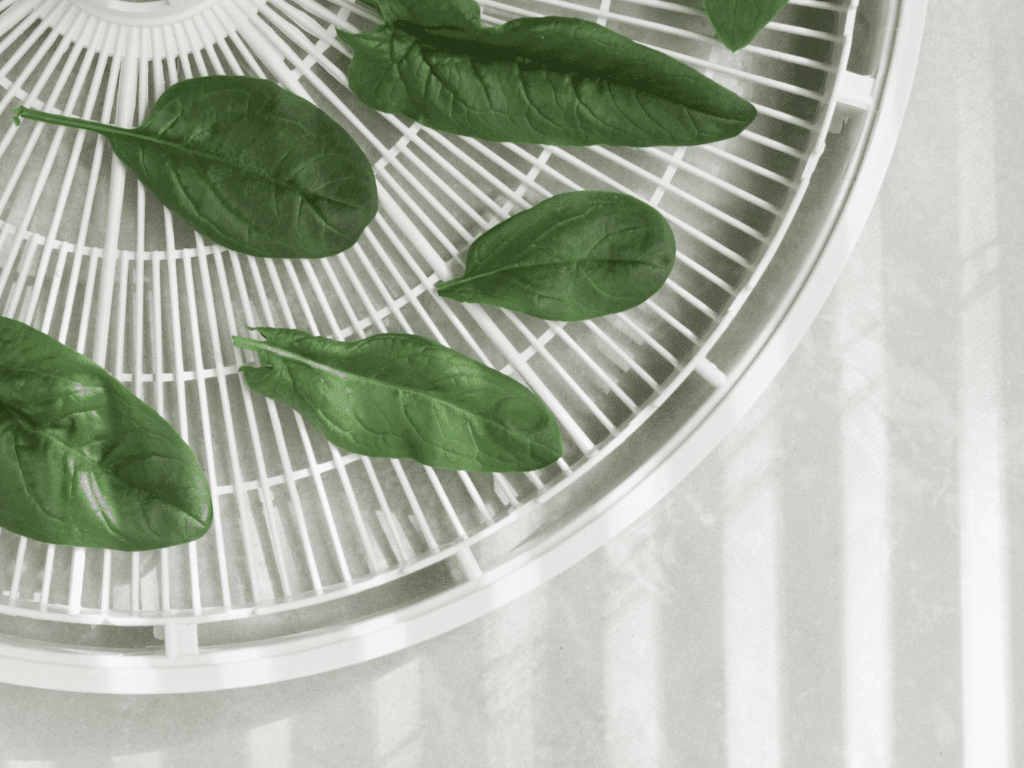Disclosure: This post contains affiliate links from SeedsNow. Read more about our ad policy here.
It’s late spring, and all of my spinach plants are going to start bolting soon. I want to preserve the last of the leaves before they turn too bitter. An excellent way to preserve fresh spinach is by turning it into a versatile and nutritious powder.

Benefits of Spinach Powder
Spinach powder retains many of the nutrients found in fresh spinach, although there may be some slight variations due to the dehydration process. Here are some key nutrients found in spinach powder and their associated benefits:
Vitamins
- Vitamin A: Spinach powder is rich in beta-carotene, a precursor to vitamin A. Vitamin A supports healthy vision, immune function, and cell growth and development.
- Vitamin C: This antioxidant vitamin helps boost the immune system, aids in collagen production for healthy skin, and enhances iron absorption.
- Vitamin K: Spinach powder is a potent source of vitamin K, which plays a crucial role in blood clotting and bone health.
- Folate: Spinach powder contains folate, a B-vitamin important for cell division, red blood cell production, and fetal development during pregnancy.
Minerals
- Iron: Spinach powder is a good source of iron, which is essential for oxygen transport, energy production, and maintaining healthy blood cells.
- Calcium: Calcium is crucial for strong bones and teeth, muscle function, and nerve transmission.
- Magnesium: This mineral supports energy production, muscle and nerve function, and plays a role in maintaining a healthy heart rhythm.
- Potassium: Spinach powder provides potassium, which is vital for maintaining fluid balance, nerve function, and regulating blood pressure.
Fiber
Spinach powder retains dietary fiber, which promotes digestive health, helps regulate blood sugar levels, and supports feelings of fullness and satiety.
Antioxidants
Spinach powder contains various antioxidants, including flavonoids and carotenoids, which help protect against cellular damage caused by harmful free radicals. Antioxidants have been associated with reducing the risk of chronic diseases, such as heart disease and certain cancers.
It’s important to note that the nutrient content and specific benefits of spinach powder may vary slightly depending on factors such as the quality of the spinach used, the processing method, and storage conditions.
Step 1: Harvesting Fresh Spinach
To begin, harvest the spinach leaves early in the morning when they are at their peak flavor and nutritional content. Choose leaves that are vibrant green, tender, and free from any signs of wilting or damage. Aim for approximately 1 pound (450 grams) of spinach for this recipe.

Step 2: Cleaning and Preparing the Spinach
Once you’ve gathered the spinach, clean it thoroughly to remove any dirt and debris. Fill a large bowl with cold water and immerse the spinach leaves, gently agitating them to dislodge any impurities. Transfer the spinach to a colander and rinse under running water to ensure a complete cleanse. Pat the leaves dry using a clean kitchen towel or paper towels.
Step 3: Dehydrating the Spinach
To transform fresh spinach into powder, we need to remove its moisture content. There are a few methods you can choose from:
Oven Method
Preheat your oven to the lowest temperature setting. Spread the spinach leaves evenly on a baking sheet lined with parchment paper. Place the sheet in the oven and prop the oven door open slightly to allow moisture to escape. Dehydrate the spinach for approximately 2-4 hours, or until the leaves are crispy and crumble easily.
Dehydrator Method
If you have a food dehydrator, follow the manufacturer’s instructions for dehydrating leafy greens. Typically, you’ll need to set the dehydrator on the lowest setting and allow the spinach to dry until it becomes brittle.

Open Air Method
Once dry, tie a bunch of spinach leaves together using kitchen twine or a rubber band. Ensure that the bunch is not too thick to allow proper airflow. Find a well-ventilated area in your home, such as a dry, warm room. Hang the bunch of spinach leaves upside down using the twine or rubber band. Make sure there is enough space between each bunch for air circulation.
Leave the spinach to air dry for several days, or until the leaves are completely crisp and brittle to the touch. This process may take around one to two weeks, depending on the humidity and temperature of your environment. Check the leaves periodically to ensure they are drying properly and there is no mold or moisture buildup. If you notice any signs of spoilage, discard those leaves and continue drying the rest.
Step 4: Grinding into Powder
Once the spinach is completely dehydrated, it’s time to transform it into a fine powder. You’ll need a blender, spice grinder, or coffee grinder for this step. Working in small batches, place the dehydrated spinach leaves into the grinder and pulse until you achieve a smooth, vibrant green powder. Repeat this process until all the spinach has been ground.

Step 5: Storing Spinach Powder
To maintain the freshness and quality of your spinach powder, it’s crucial to store it correctly. Transfer the powder into an airtight container, preferably a glass jar with a tight-fitting lid. Keep the container in a cool, dry place, away from direct sunlight. When stored properly, spinach powder can retain its nutritional value for up to a year.

By making spinach powder from fresh spinach, you’re not only extending the shelf life of this nutritious leafy green but also ensuring that you have a versatile ingredient at your disposal throughout the year. Whether you add it to smoothies, soups, sauces, or baked goods, spinach powder is a fantastic way to incorporate the benefits of spinach into your daily diet.












